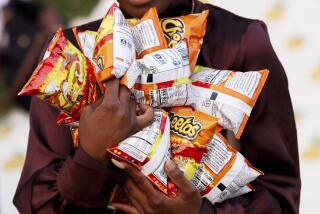For Pepsi drinkers, did the caramel color come with risk?
- Share via
PepsiCo Inc., the makers of Pepsi One, the diet version of its popular soft drink, says it is in the process of lowering the levels of caramel coloring in its products to meet state regulations requiring reduced amounts of a chemical believed to cause cancer. But the change in formula shouldn’t affect the soda’s taste.
“All of our products are in full compliance with the law,” a PepsiCo representative told The Times in an email. “When the regulatory requirements changed in California, PepsiCo moved immediately to meet the new requirements, and all of our products in California are below the California threshold.”
All the PepsiCo product changes in formula should be complete by February. And the representative stressed that the change would not affect the taste. But according to Consumer Reports, that’s too late.
California Prop. 65 requires any product containing more than 29 micrograms of 4-methylimidazole (4-MeI), a possible cancer-causing chemical found in artificial coloring, per day, to have a warning label. Some kinds of caramel coloring contain the chemical.
The amount of 4-MeI in soda was recently highlighted in a study done by Consumer Reports. The study looked at 81 different sodas purchased in California and New York between April and September 2013.
Samples taken from Pepsi One bottles in California between April and September 2013 contained 43.5 micrograms of 4-MeI, and 39.5 micrograms in bottles tested in December 2013. None of the bottles contained a warning label. That’s more than a year after the label regulations had been put in place.
They found that Coke, Coke Zero and Diet Coke products contained fewer than 5 micrograms.
When asked about the discrepancy in time between Pepsi’s change in formula and when the regulations were established, the PepsiCo spokesperson reiterated her previous statement regarding all PepsiCo products being in full compliance with the law.
“There’s no reason why consumers should be exposed to an avoidable and unnecessary risk that can stem from coloring food brown,” said Urvashi Rangan, toxicologist and executive director of Consumer Reports’ Food Safety & Sustainability Center on ConsumerReports.org. “Manufacturers have lower 4-MeI alternatives available to them. Ideally, there would be no 4-MeI in food.”
Consumer Reports cited a PepsiCo statement in which the soda giant claimed that it was not breaking any laws because people on average drink 100 milliliters per day of soda, or less than a third of a 12 ounce can. The company pointed out that the law refers to per day exposure to the chemical. If someone drinks less than a third of a can, that’s under the 29 micrograms.
According to The Times’ David Pierson, the magazine on Tuesday asked the California attorney general to look into warning labels for Pepsi One and Malta Goya, another soda that contained more than 29 micrograms of 4-MeI.
Want more food news? Follow me on Twitter: @Jenn_Harris_
ALSO:
Latin-themed dim sum as John Sedlar introduces new menu at Rivera
Shrimp and mayonnaise Doritos, plus 14 other Japanese chips we want now
Please, don’t buy a peach in January: When the fault is ours and not the supermarkets’
More to Read
Eat your way across L.A.
Get our weekly Tasting Notes newsletter for reviews, news and more.
You may occasionally receive promotional content from the Los Angeles Times.











